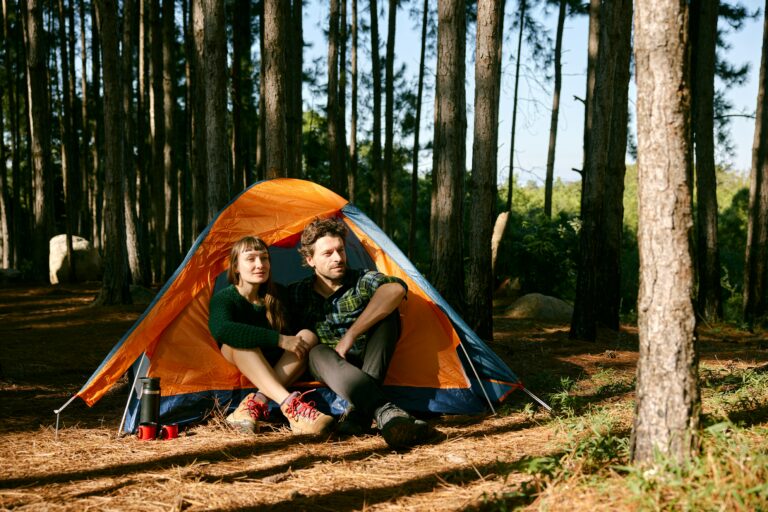Outdoor specialist shares the most important technique for surviving animal encounters
Key Points:
- Camping expert reveals the most important action to take when encountering wildlife while camping – avoid direct eye contact while keeping the animal in sight
- Expert explains why running away or making sudden movements could trigger an animal’s predatory instincts and lead to an attack
- Expert warns that direct eye contact can be interpreted as a threat by predators like mountain lions and wolves, making the situation more dangerous
When enjoying the great outdoors, coming face-to-face with wildlife can be both thrilling and terrifying. While the chances of encountering dangerous animals during a camping trip might seem remote, being unprepared for such situations could put you at serious risk.
“Campers usually panic when they unexpectedly encounter wildlife, which is exactly what you shouldn’t do,” explains Andy Halliday, camping expert at Lexrope, a UK-based company specialising in outdoor camping gear and accessories. “The single most important rule to remember is to avoid direct eye contact while keeping the animal in your peripheral vision.”
Halliday’s advice comes at a time when more Britons are exploring the countryside and national parks, often without proper knowledge of how to safely navigate wildlife encounters.
Why Eye Contact Is A Dangerous Move
When face-to-face with wildlife, your instinctive reaction might be to stare directly at the animal. However, this could be a dangerous mistake.
“Direct eye contact is interpreted as a threat or challenge by many wild animals, especially predators like mountain lions, wolves, and even some bears,” Halliday explains. “It’s similar to how a stranger staring at you might make you feel uncomfortable or threatened.”
Instead, Halliday recommends keeping the animal in your peripheral vision. This approach allows you to monitor its movements and location without appearing confrontational.
“You want to maintain awareness of where the animal is and what it’s doing without challenging it. Use your peripheral vision to track its movements while you slowly prepare to respond appropriately,” he advises.
Common Mistakes That Could Put You In Danger
According to Halliday, running away is one of the worst responses when encountering wildlife.
“Running triggers a predatory chase response in many animals,” says Halliday. “Even animals that might not otherwise attack humans can be prompted to chase if they see you running. This is deeply ingrained in their hunting instincts.”
Another common mistake is making sudden movements, which can startle the animal and provoke a defensive attack.
“Wild animals are constantly on alert for threats. A sudden movement might be misinterpreted as aggressive behavior, causing the animal to defend itself,” Halliday notes.
Screaming or making loud noises can also escalate the situation with certain animals, though Halliday points out that this varies by species.
What To Do Instead
If you find yourself face-to-face with wildlife, Halliday recommends following these steps:
1. Stay calm and avoid panic: Keep your breathing steady and try to control your fear. Animals can sense fear and anxiety, which might make them more nervous or aggressive.
2. Avoid direct eye contact: Look at the animal’s feet or just past its shoulder rather than directly into its eyes, while still keeping it in your field of vision.
3. Back away slowly: Make gradual movements to increase the distance between you and the animal. Don’t turn your back completely.
4. Make yourself appear larger: If the animal continues to approach, raise your arms, open your jacket wide, or lift your backpack above your head to look bigger.
5. Speak in a low, calm voice: This lets the animal know you’re human and may help prevent it from seeing you as prey.
“These techniques work for most wildlife encounters in the UK and beyond,” says Halliday. “However, specific animals might require slightly different approaches, which is why it’s worth researching the wildlife in your camping area before you go.”
Andy Halliday, camping expert at Lexrope, commented:
“The British countryside is generally safe, but wildlife encounters can happen when you least expect them. The difference between a good story to tell your friends later and a dangerous situation often comes down to your immediate reaction. By avoiding direct eye contact while still keeping the animal in sight, you’re communicating that you’re neither prey nor a threat.
“I’ve spoken with many campers who instinctively ran when they spotted wildlife, not realizing this could trigger a chase response. Others have tried to appear dominant by staring down the animal, which can escalate the situation. The key is finding that middle ground – being aware without being confrontational.
“Remember that most wild animals aren’t looking for trouble. They’re usually more afraid of you than you are of them. Staying calm, making yourself appear larger, and backing away slowly while avoiding eye contact means you’re giving both yourself and the animal the best chance to walk away safely from the encounter.”
